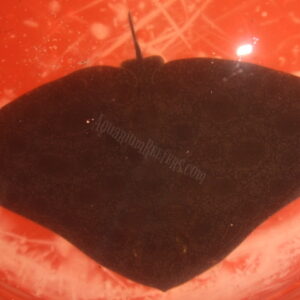Description
The Volitans Lionfish, scientifically known as Pterois volitans, is a striking and beautiful fish with a maximum size of approximately 15 inches (38 cm). It has elongated, venomous spines on its back and pectoral fins, which give it an elegant and captivating appearance. The body is covered in bold stripes and patterns, typically consisting of red, brown, and white.
Taxonomy
The Volitans Lionfish belongs to the genus Pterois and the family Scorpaenidae. It is closely related to other lionfish species within the same genus, such as the Radiata Lionfish (Pterois radiata) and the Antennata Lionfish (Pterois antennata). The scientific name, Pterois volitans, is derived from the Greek word “pteroin” meaning “feather,” and “volitans” meaning “flying,” referring to the fish’s feathery fins and graceful movements.
Natural Habitat
In its natural habitat, the Volitans Lionfish can be found in warm tropical and subtropical waters, primarily in the Indo-Pacific region. It inhabits coral reefs, rocky crevices, and lagoon environments. These fish are often found hiding among corals, rocks, or other structures, using their elaborate camouflage to blend into their surroundings.
Keeping Volitans Lionfish Healthy:
The Volitans Lionfish requires attentive care to ensure its health and well-being. It is considered to have a moderate care level and can be moderately challenging to keep. Some key aspects to consider for keeping this fish healthy include maintaining proper water quality, providing a suitable tank setup, and offering a balanced diet.
Special Requirements and Feeding
Volitans Lionfish have specific requirements that need to be met in captivity. They require a spacious aquarium with plenty of hiding places, such as caves or rock formations, to mimic their natural habitat. The tank should have excellent filtration and regular water parameter monitoring to maintain stable conditions. As carnivorous predators, Volitans Lionfish feed on a diet of live or frozen meaty foods, such as small fish, shrimp, and crustaceans.
How Many Should I Keep?
It is recommended to keep only one Volitans Lionfish per aquarium due to their territorial nature and potential aggression towards tank mates. Keeping multiple lionfish together may result in aggression and fights over territory.
Hunting Method
Volitans Lionfish are skilled ambush predators. They use their elaborate fins and stealthy movements to stalk and capture prey. When hunting, they remain motionless and blend into their surroundings, waiting for smaller fish or crustaceans to come within striking distance. Once the prey is in range, the lionfish rapidly extends its mouth and engulfs the prey with its expandable stomach.
Lighting Preference
Volitans Lionfish prefer moderate to low lighting conditions in the aquarium. This lighting setup helps to create a more natural and dimly lit environment that mimics their natural habitat.
Suitable Tank Mates
Care should be taken when choosing tank mates for Volitans Lionfish. They are not suitable for reef tanks with smaller fish, crustaceans, or delicate invertebrates that they may prey upon. Compatible tank mates can include larger, robust fish species that are not easily intimidated or targeted by the lionfish.
Reproduction in the Wild
In the wild, Volitans Lionfish (Pterois volitans) engage in sexual reproduction to produce offspring. They have a fascinating reproductive process that involves courtship, spawning, and the subsequent rearing of their young.
Breeding Pterois volitans:
Breeding Volitans Lionfish in captivity, although challenging, is possible with the right setup and conditions. Successful breeding requires careful attention to the following stages: set up, courtship/spawning, and rearing.
- Set Up
To encourage breeding, a dedicated breeding tank should be set up. The tank should have appropriate water parameters, including a temperature range of 78°F to 82°F (25°C to 28°C), pH between 8.1 and 8.4, and a salinity level of around 1.023 to 1.025.
- Courtship/Spawning
Volitans Lionfish engage in elaborate courtship displays before spawning. The male initiates the courtship process by displaying his vibrant colours, extending his fins, and performing rhythmic movements to attract a female. Once the female is receptive, both fish rise to the water surface, where the female releases her eggs and the male fertilizes them externally.
- Rearing
After successful spawning, the eggs float near the water surface, where they are vulnerable to predation. To increase the chances of survival, the eggs can be carefully collected and transferred to a separate rearing tank with appropriate water conditions. The eggs typically hatch within 48 to 72 hours, and the newly hatched larvae, known as fry, require specialized care.
Sexual Dimorphism
Volitans Lionfish do not exhibit significant sexual dimorphism, meaning there are no distinct physical differences between males and females.
Distribution
The Volitans Lionfish is naturally distributed in the Indo-Pacific region, including the Red Sea and the coast of East Africa. While there are captive-bred and line-bred strains available in the aquarium trade, the original wild fish originate from the Indo-Pacific region.
Summary
The Volitans Lionfish, Pterois volitans, is a visually striking species known for its elongated spines, vibrant colour, and predatory behaviour. Breeding these fish in captivity requires a dedicated setup with appropriate water parameters, courtship displays, careful spawning management, and subsequent rearing of the fry. They are naturally found in the Indo-Pacific region, and while captive-bred strains are available, the original fish come from this region. Breeding Volitans Lionfish is a rewarding but challenging endeavour that requires attention to detail and a thorough understanding of their reproductive behaviour.
The Fish pictured here are representative only and the livestock you receive may vary in pattern, coloration, and shape.









Reviews
There are no reviews yet.